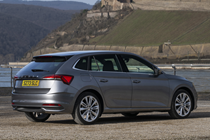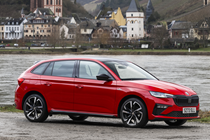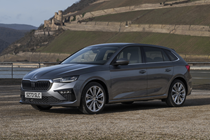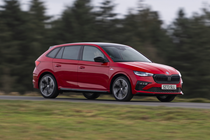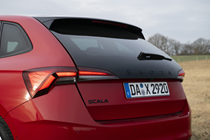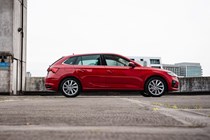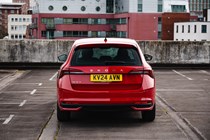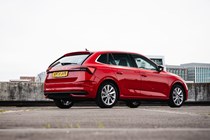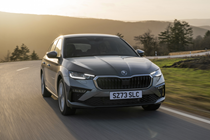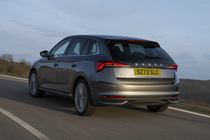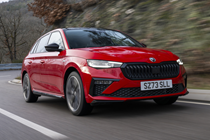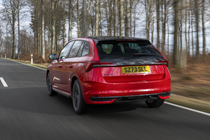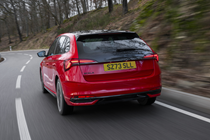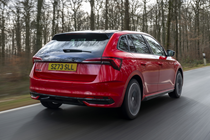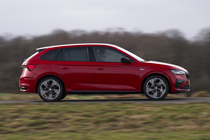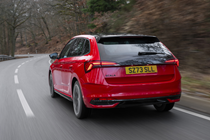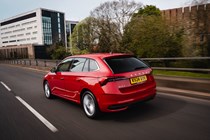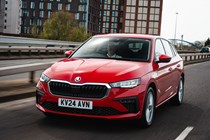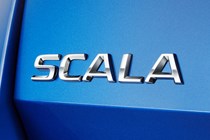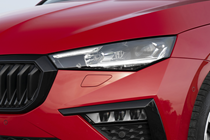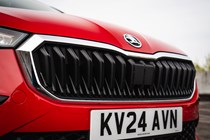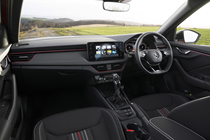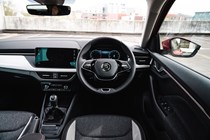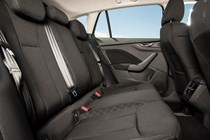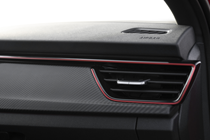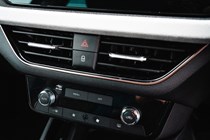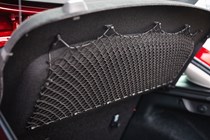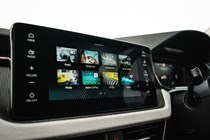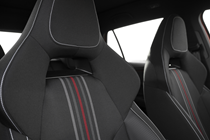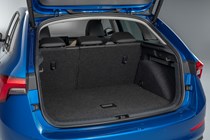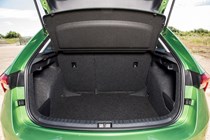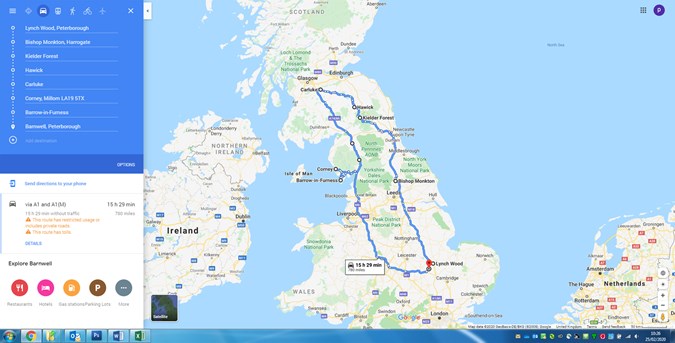
Skoda Scala long-term test
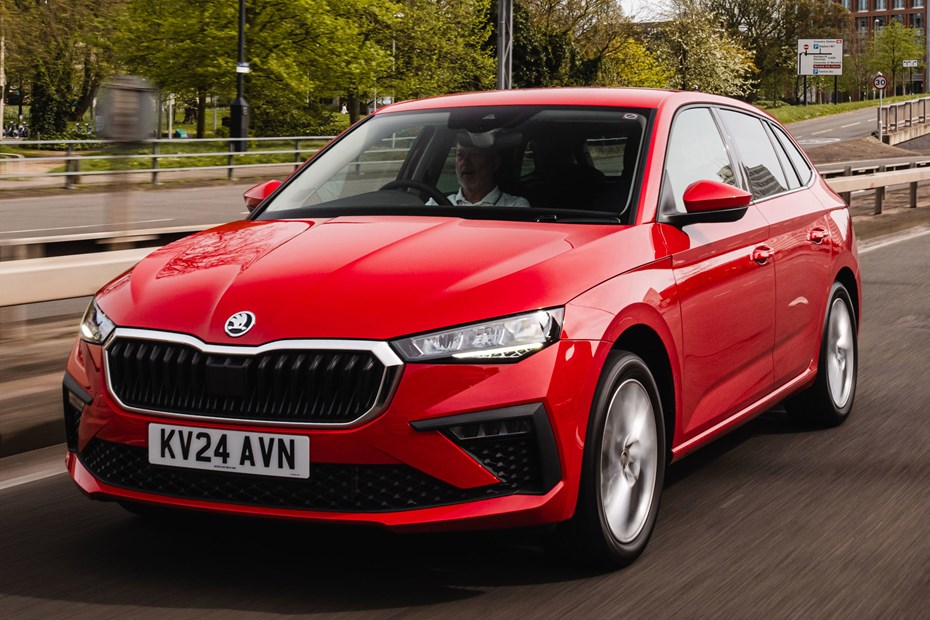
Long Termer – reports by Steve ‘Percy’ Lawman
Update 1: Welcome to Parkers – my ‘Simply Clever ‘ companion
It’s a New Year and time for a new driving experience in this corner of the office. After a restful few weeks in the southern hemisphere over Christmas, I’ve returned back to UK trying to re-acclimatise after the 50 degree plus heat of Australia.
At the office there’s a new addition parked outside in the shape of KY69 MTK a bright and shiny ‘Race Blue’ metallic Scala courtesy of our friends in the Skoda press office. It looks very smart even on a cold murky January day in the UK. Derived from the Latin word meaning ‘stairs’ or ‘ladder’, Skoda take the next leap forwards and upwards with the new technology Scala.
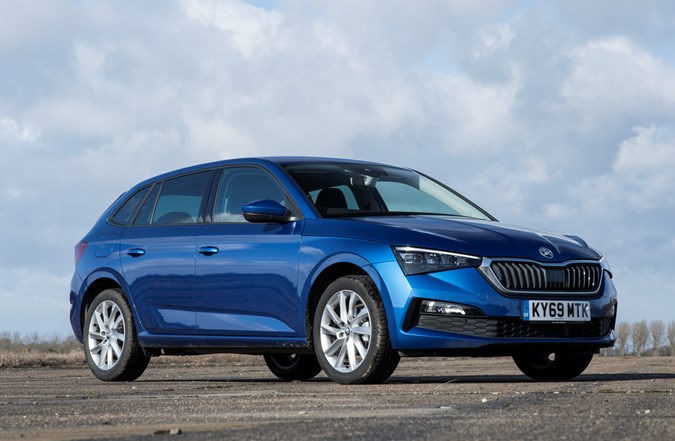
Replacing the Skoda Rapid Spaceback which ended production in 2019, the Scala is pitched in a sector that has some pretty heavyweight contenders. Cars such as the Ford Focus, VW’s Golf, Hyundai’s i30 and the Vauxhall Astra are just some of the well know powerhouses its up against, so it’s going to be a tough job and certainly no walk in the park.
At 4362mm it’s quite long for a 5 door hatchback, but that gets the big thumbs up, as first impressions on inspecting the car revels oodles of boot space and plenty of room in the rear of the cabin for lanky 6 footers like me. Size-wise it seems to fit in between the Fabia and Octavia as when you view the Scala side on, it looks like it’s been stretched out somewhat.
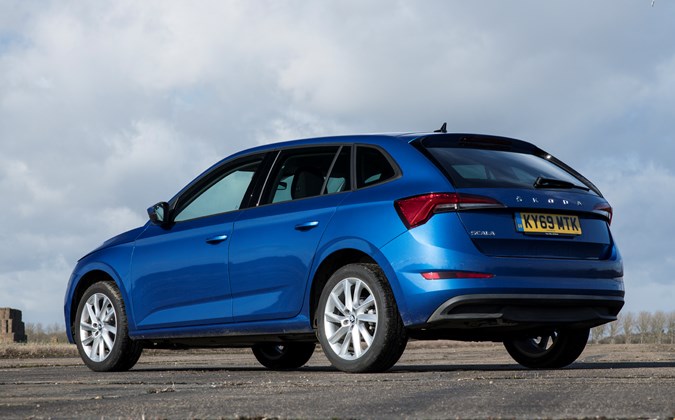
The Scala is available in four different engine guises all of which have been available since launch in July 2019. The 1.0TSI petrol is available in both 95 and 115PS outputs and topping the petrol line-up is the 1.5TSI 150PS engine. There’s one offering for diesel buyers in a 1.6TDi power unit. All four engines are available with either manual transmission or 7-speed DSG variants.
What we did find interesting when checking over the technical data is the CO2 emissions from the three different petrol variants. In theory you’d expect the lowest output engine (95PS) to have the lowest emissions – in this instance it wasn’t the case.
The smaller 1.0 TSI 95PS engine has CO2 emissions of 114g/km which compared to 111g/km for the 1.0 TSI 115PS engine. The higher power 1.5 TSI 150PS engine only emitted 115g/km, so on the face of it out of all three, is the better engine to have. Take into account also that the £145 annual road tax fee is the same, whatever engine you chose.
>> Check out the specs of our own long-term Scala
>> Check out the specs of other Skoda Scala’s in the range
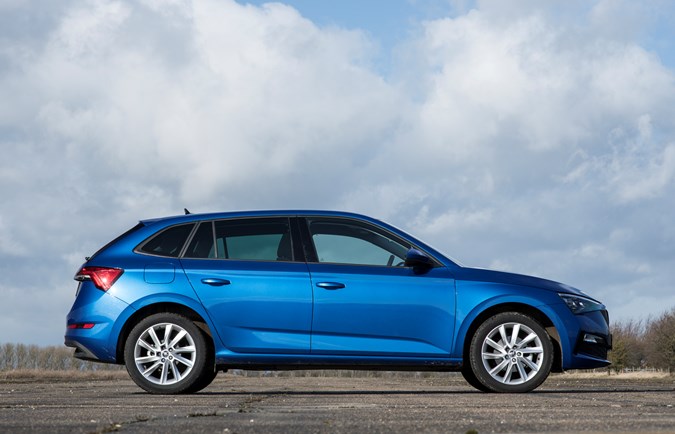
There are three trim levels on offer, these being S, SE and SE-L. Cars in S or SE trim are only available with petrol engines. Our own car is a 1.5TSi 150PS DSG and is one of the higher spec cars in SE-L trim which offers a myriad of both standard and optional equipment.
For starters and just to whet your appetite, all SE-L models have Amundsen satellite navigation utilising a wonderful high-resolution 9.2 inch screen. 17 inch Stratos alloys, Cruise Control, DAB, Lane Assist, Smart Link (which includes Apple CarPlay, Android Auto and MirrorLink) and a Virtual Cockpit to name just a handful from the goodie bag. On top of an already excellent standard equipment list, we have two items from the optional equipment list including Full LED Headlamps at £800 and Metallic Paint at £595.
The stock 1.5TSi SE-L (150ps) DSG trim car comes in at £23,400 RRP and with the additional options, tops the scales at £24,795. But it’s here where we can see the Scala facing up well against its competitors as the Scala’s starting list price is below that of all its rivals and sometimes by a considerable margin.
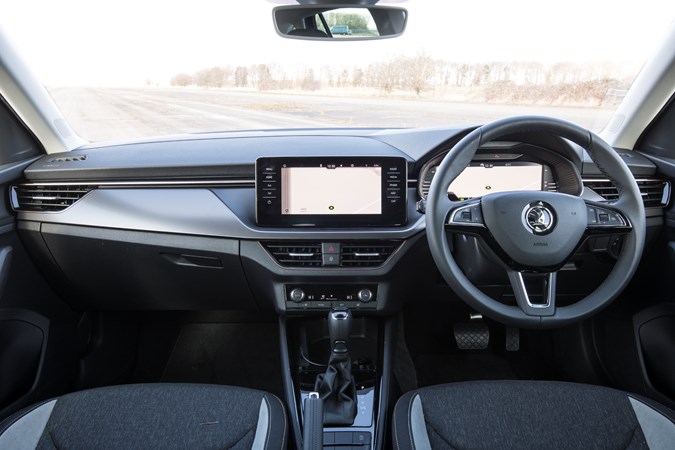
I suppose it’s akin to the ‘Aldi’ of hatchbacks with Skoda offering a really great product at a price often below that of the competition with the pointless badge snobbery factor being kicked firmly into touch.
Our Scala has arrived in the midst of winter but the loan period spans into the early summer period so I’m looking forward put it’s through its paces across all three seasons.The wide scope of differing road and weather conditions should be a good test to see how the car copes in the real world.
Catch up with me later in February for some real-world driving impressions as I take the Scala North of the Border for a 780 mile weekend jaunt.
Update 2: Driving impressions and performance/handling
To give me a good first feel of the Scala, I decided to have a weekend away going North of the Border. The trip would take me across fairly varied terrain heading from Peterborough up to Wetherby for an overnight, then on the following day to Carluke (just South of Glasgow) and finally onto Barrow-in-Furness via some high-ground in Cumbria to attend a birthday celebration.
Having only had the Scala for a few weeks, I’m noticing straight away even with a brand new car that the fuel economy looks extremely good. My first splash of fuel was a fill up in early January and the 49.69 litres (£62.00) carried me just under 650 miles albeit over fairly slow country roads and smaller ‘A’ roads. Pretty impressive stuff to say the least especially when the official WLTP figure is 616 miles a tank – and with a new engine that still is a little tight. So I’m expecting further improvements over time as the power unit loosens up.
So on a cold February Friday afternoon, I made my way north on the A1 arriving just East of Harrogate in just over 2½ hours. The A1 was a bit of a stop/start affair with the high volume of traffic slowing the proceedings down somewhat. Given the circumstance, the Scala’s DSG performed well. It does however have its own personality.
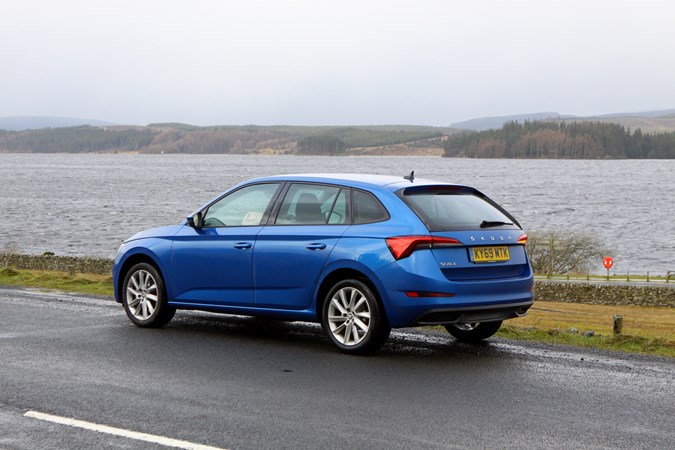
In normal ‘drive’ mode, the shifting upwards of the 7-speed DSG unit seemed fairly rapid. The software senses to move the DSG up to the next gear when the revs hit just below the 2000RPM level. On a flat surface and under a fairly gradual acceleration, this is adequate. If however you find you need just that little bit more, you need to push the throttle downwards, almost past the ‘Cruise’ position. Here the software detects that more ‘ooomph’ is required and thus the upward shift in the DSG happens at higher revs. It actually works quite seamlessly but can take a while to get used to, especially where you need to position your right foot. In the extremes and if you need everything (and quickly), the engine responds rapidly giving you the full 150 horses with no delays.
You can of course introduce a little manual intervention. The DSG can be overridden from the gearshift lever by moving the lever to the left. This enables a manual version of the DSG. Pushing up or down effectively shifts up or down the gearbox, it’s akin to a manual gearbox which can be useful for instance of towing amongst other things.
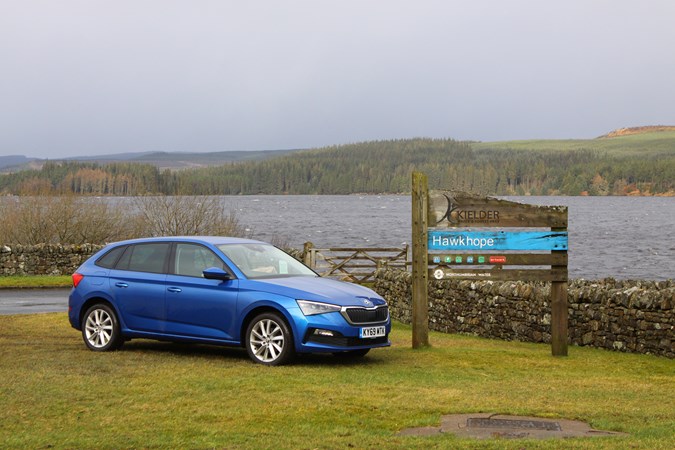
On the second leg of my journey, the DSG in manual action came into its own. The roads from North Yorkshire to the Scottish borders flow fairly freely but there’s often long runs of undulating twists and turns that lend themselves well to a brisker driving style. Using the Scala in manual mode gave the driver a much sportier experience as the response to the gear changes were both swift and positive. As an alternative to going all on main roads, I decided to take the Scala cross-country via Kielder Forest. On the lesser roads the Scala coped well but it was here I seemed to notice quite a dip in fuel economy. We’re keeping a daily fuel log as there’s a reasonable variation depending on the load and speed. The type of road also adds something to the mix as the consumption average went from around 13.14 miles-per-litre to around 11.89. Saying that and given the circumstances, these are highly respectable figures. Converting 13.14mpl to mpg is around 59.13 and 11.89 converts to 53.5mpg – so stay tuned for further updates as under the right driving conditions, this car looks to be a winner.
Can I see another Land’s End to John O’Groats fuel test on the horizon? – See here when I took a Suzuki Ignis from one end of the country to the other and got the certificate to prove it.
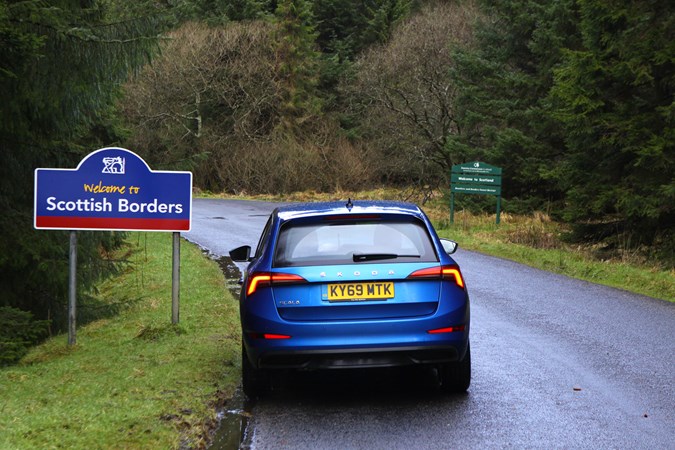
After a quick stop-off to see a friend in Carluke, it was motorway time. The M74 southbound looked pretty quiet. Maybe it’s a Saturday and the weekend I thought, but nice all the same and it makes a change from the hustle and bustle of motorways further South.
Here I gave the Scala’s cruise control its first workout. As I’d noticed that the fuel consumption had dropped, I set the control at a modest 60mph, enough to keep the trucks behind me but to take stock. The functionality is actually simplicity at best. A small switch on the top of the left-hand steering column stick switches the control ‘On’, however at this point it’s not fully enabled. You then need to select the speed (easily set) with another rocker switch on the side of the same control stick. Rock-down to set the existing speed (or increase) or rock-up to slow down. It all works so well with no fuss. I really like this feature and out of all manufactures, the Skoda one is just simply clever.
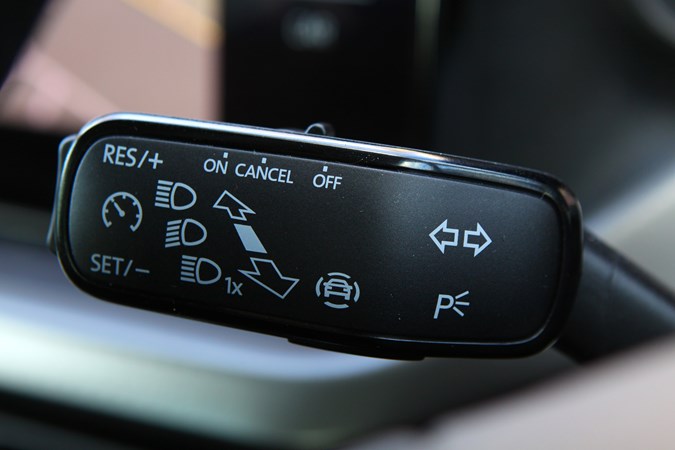
After an overnight in Barrow, it was time to put the Scala through its penultimate test. Having visited friends in Cumbria since the late 70’s, I’ve got to know my way around the area pretty well – especially some of the minor roads. I had been introduced to a good section of high ground locations back then, as we’d used some as for our ham radio activities.
One favourite is ‘Corney Fell’ – a place high enough to see the Isle of Man and even the Northern Irish coast on a clear day. It sits at around 1500 feet ASL and is accessible from a ropey old back road, complete with potholes. Whilst the weather can be good before the accent – you can have horizontal rain and howling winds at the summit. Today I was not disappointed and the later was the exact recipe I got.
Ascending ‘Corney’ via the ‘main’ back road called for the Scala’s DSG to be in manual. The fairly steep accent required frequent gear shifts and although I tried in full ‘DSG’, the engine revs and change ups were at too low revs. Using the box in manual-mode gave me much more control given the situation.
The final run on the journey back home was via the A590 and then M6 South. The A590 is a good mix of faster straights and slower twisty sections. The power of the 1.5TSi 150PS engine came into its own on the steady climb up towards High Newton. It’s a fast and long dual carriageway stretch of about 2 miles which climbs steadily. At the summit you have great views of Morecambe Bay to the South East. The Scala met the challenge with ease and the engine/DSG combination worked well as the cruise never required any gear-shifting downwards.
In conclusion, the trip was varied enough to test the all-round agility of the Scala across differing road and weather conditions. I did notice that it can be a little bouncy at lower speeds. There’s also a fair amount of body lean with the standard suspension – this is something you can dial out by adding the optional adaptive suspension and switching it to the stiffer Sport mode. This would be a useful option to owners wanting that ‘Sportier’ fast-road feel. Overall though, the Scala gets the thumbs up as being a great and very capable all-rounder doing a good solid job.
Above is a Google map showing the detail of the trip.
The overall distance was 780 miles which was covered over two days and nights.
Update 3: Interior, boot and practicality
As our model is the higher spec SE-L, we have the luxury of options over and above the standard S and SE models. The Amundsen Sat-Nav and virtual cockpit are a great addition, the 9.2 inch grabbing your attention as soon as it boots up. Screen resolution is excellent and the touch screen extremely responsive. In use, you can swiftly move through the menus at speed as there is virtually no delay. It’s swift and precise and after a minimal boot-up time is ready for use.
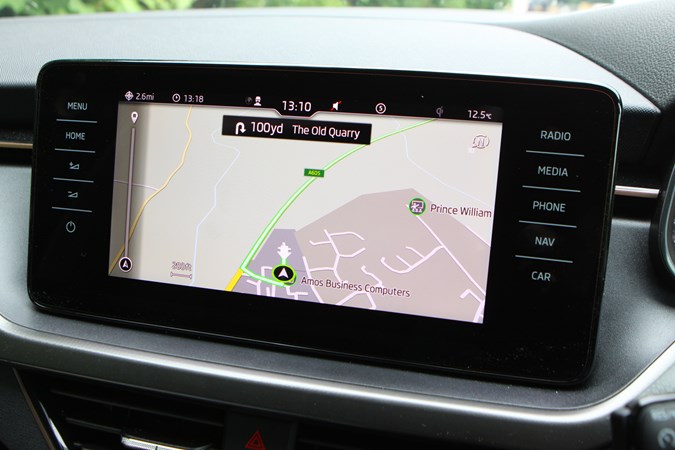
Entering in a new navigation point is very straightforward. You can either enter a place or street name and in addition the system will search postcodes and return a latitude and longitude reading. Although the maps refs are nice, they’re not really needed and most users would be happy just to see a street or road name. Once the place is confirmed, the system gives users various options on reaching the destination including options in the menu such as whether to use tolls etc. All-in-all, it’s all very intuitive and fairly straightforward once you know your way around the menus.
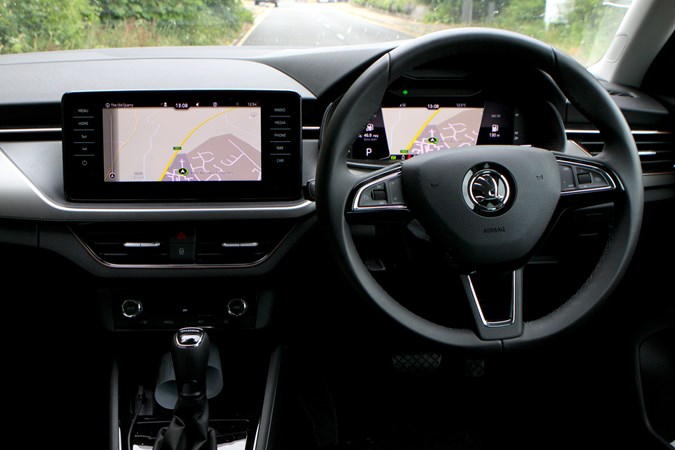
Here’s the pinnacle of practicality. An ice scraper in the fuel filler flap which is a really nice touch. How often have you woken to find your car covered in ice and not an ice scraper to be found?. You then spend 10 minutes or so trying to de-ice your car using a coat sleeve, your hands and ‘hot’ breathe.
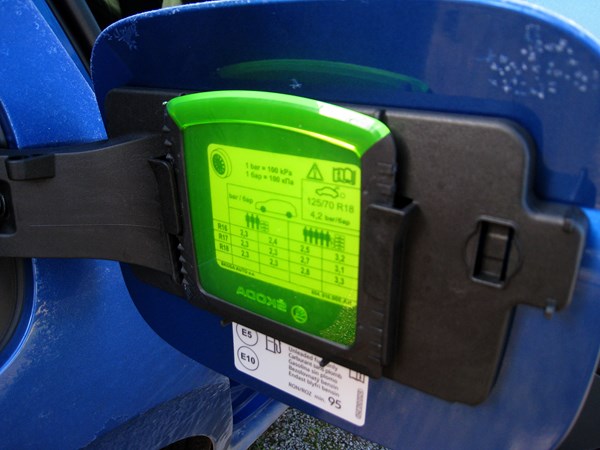
Well, Skoda’s novel solution is to put an end to all that shenanigans as they supply you with a neat day-glow scraper located just inside the fuel filler cap. Here it won’t get lost and the access is easy. More so as the fuel filler cap is not a lockable affair and can be opened without having access to the interior of the car. Some could say this is a little risky as anyone (could potentially) just pop open the fuel flap and steel your ice-scraper. Not that people are that desperate – are they?
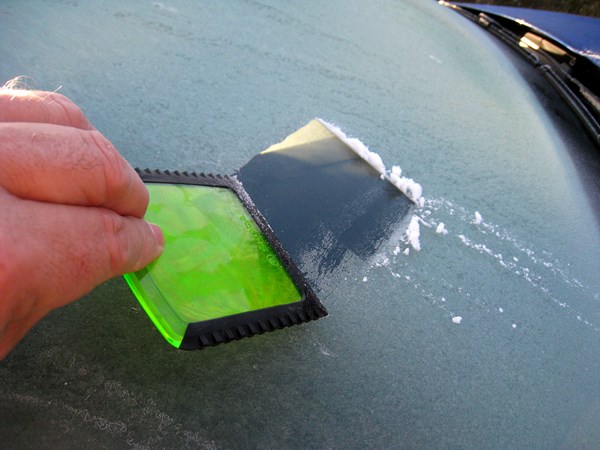
With its elongated body, the Scala bodes well for carry large, or even longer loads that other hatches just wouldn’t cut the mustard. Having just collected some thin but long aluminium tubes, I was surprised that the Scala would fit in tubes of just under 2.5m in length with ease. Just drop the rear seats down, and of course with some protective covers to prevent damage – lay the tubes in between the two front seats.
In the boot itself you have a very generous 467 litres of space, spilt-fold rear seats and bags of room for passengers in the rear. The rear doors are nice and wide making access as easy as possible. It’s practicality on a proper scale and it’s done very well.
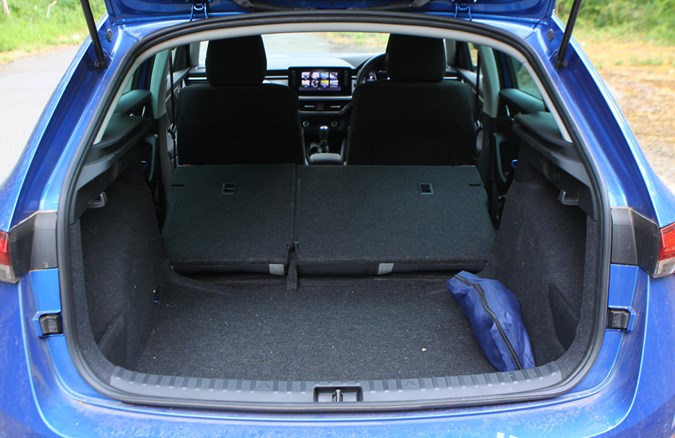
The proverbial trip to a supermarket always gives us some good real-world indications of what a car is capable of carrying. We’d normally load the boot with as many shopping bags as possible, but in the case of the Scala, extending the boot with the rear seats down actually gave us so much room that we’d need about 20 bags to fill it.
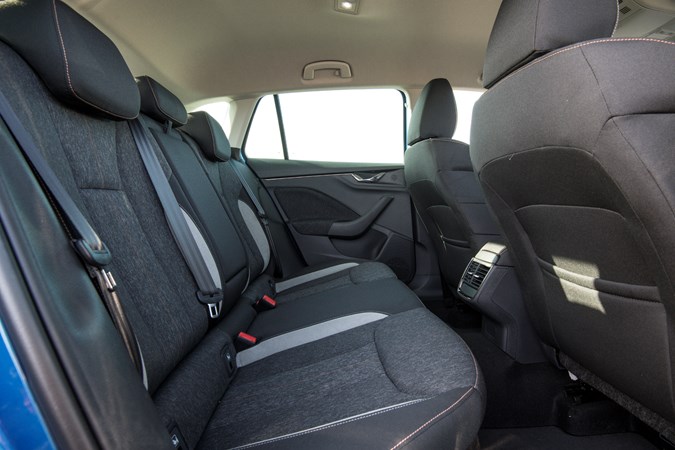
Inside, the Scala is both practical and comfortable. Space in the rear is excellent and you can easily fit in a 6 foot adult with plenty of leg room to spare. Visibilty is good, mainly due to the slimmed down pillars and with huge swaths of glass, you get a really nice wide ‘depth-of-field’ feeling.
Update 4: How to get your hands on a brand new Scala
Well, as the country gradually eases itself from lockdown, we’ll look to get motoring again and see what different options there are in running a Skoda Scala. A few years ago the car buying experience was a quite straightforward affair. Today there’s a vast array of options available to potential owners. We’ll look and dissect each one giving you the rundown and how much it wil hit your wallet. We’ve searched exactly the same trim level so it’s a like-for-like comparison. However, fitted options are not included as cars can normally be ordered to a specific buyer specification.
Option 1 – Outright Cash Purchase
This is the ‘Old ‘Skool’ way of owning a car. A few years ago it was about the only way you could get your hands on some new metal. Some owners still prefer it this way, so here’s the nitty-gritty.
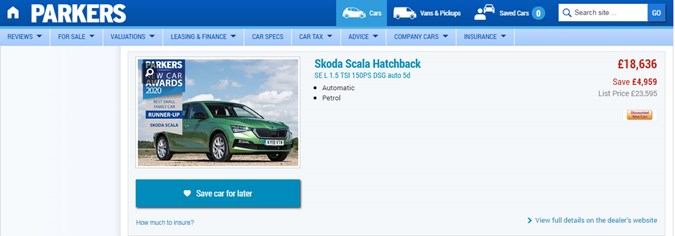
Searching Parkers Cars For Sale [New Cars] revealed a good selection of new Scalas with most trim levels available. We found a 1.5 TSi SE L [150ps] DSG auto for £18,836 from our friends at Discounted-New-Cars.com. The price is inclusive of VAT and represents a saving of just under £5000 on the recommended retail price of £23,595. If you have the cash and want a great deal [saving thousands on the RRP] – then this is the way to go. The car is yours, owned outright and there’s no restriction on mileage which you can have with other type of deals such as PCP.
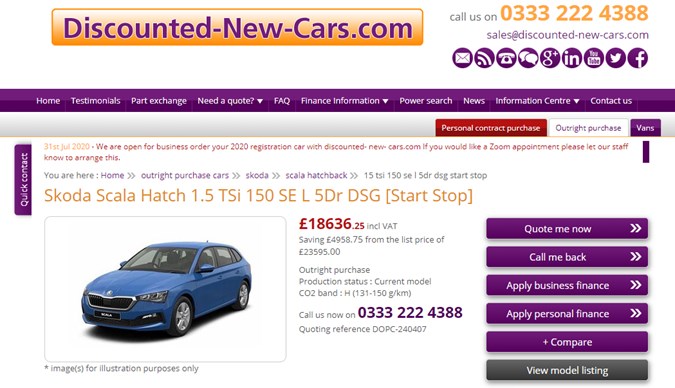
Option 2 – Outright Purchase Using a Personal Loan
This is not that disimillar to an outright cash purchase. In essence they are pretty well the same, the caveat being is that rather than using readily available cash; you apply for a loan from one of the many banks and companies offering these services. A quick online search reveals hundreds of different loans available. It can however be quite a minefield when searching.
Unlike previous searches for loans, this time our old favourites didn’t fair that well. Providers such as John Lewis Finance and Asda Money both had high APR rates although Tesco bank came in at a very nice 3% and is certainly worth looking at. Asda were really off the mark at 9.9% and not worth following up on. New kid on the block ‘TSB’ came good with a great APR of just 2.8%. You can see comparing both loans that the TSB loan saves you nearly £60 per month on interest charges compared to Asda. Certainly not to be missed especially when you work out that over the lifetime of the loan, you save yourself a massive £3451 on interest payments alone.

Obviously everyone’s financial circumstances are different so we can’t recommend a specific loan for you, but here’s some online examples as of 31/7/2020 just to give you a taster of what to expect to borrow and what it would cost per month to pay the loan back.
As per the outright cash purchase in Option 1, the car will be owned by you with no restrictions.
Asda Money
Loan Amount: £19,000 over five years
APR 9.9%.
60 monthly repayments of £398.82
Total repayable £23,929
Asda loan information here
TSB
Loan Amount: £19,000 over five years
APR 2.8%.
60 monthly repayments of £339.81
Total repayable £20,388
TSB loan information here
Parkers Tip
Always look for a loan with the lowest APR rate. The higher the APR charge, the more you’ll repay when borrowing money. An overall APR charge applies to finance deals such as PCP and Hire Purchase schemes – as well as bank loans – and the lender must tell you what this figure is before you sign an agreement.
See the Parkers guide to APR here.
Option 3 – PCP [Personal Contract Purchase] and PCH [Personal Contract Hire] Leasing
These are new and modern approaches to running a car. We emphasise the word ‘running‘ because in a PCP or PCH agreement – you don’t actually own the car; although with PCP under some circumstances you may be able to purchase it with an ‘Optional Final Payment‘ after the initial PCP agreement period has ended.
PCP stands for ‘Personal Contract Purchase’. It works by spreading the price of a car across a deposit, a series of monthly payments, and an optional final payment. Typically a PCP finance agreement lasts between two and four years.
Unlike with a bank loan – where you pay for the whole cost of the car over the contract – with PCP you just pay for the depreciation; that’s the difference between the initial price and what the car is expected to be worth when you hand it back.
PCH stands for ‘Personal Contract Hire’ – basically you hire the car for a certain period of time after putting down a deposit. Deposits vary and some providers require no deposit at all [although monthly rentals are often higher]. At the end of the contract period there is no option to purchase and you just hand the car back.
When searching [31/7/2020] on Parkers New Car Leasing Deals, our partners at Zen Auto were showing the cheapest PCH deal at £293 per month. This term was over a 4 year period with a £2000 deposit, a processing fee of £199 and an annual mileage of 8000. Other deals [such as the same criteria but with an enhanced 12,000 miles p/a option] showed at £307 per month.
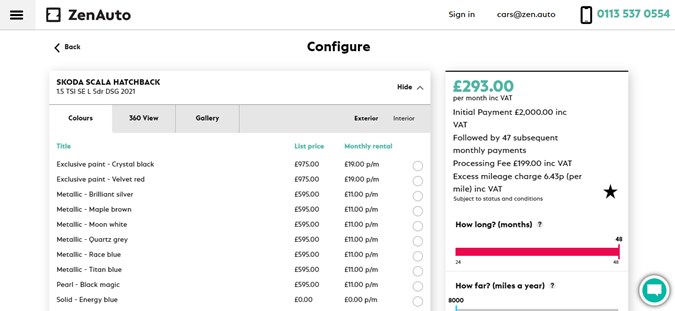
See the Parkers guide to PCP Car Finance here
Option 4 – Purchase a Second-hand Car
Buying a late/used low mileage secondhand car can save you literally thousands. In the car world, the most depreciation in a car’s value occurs within the first three years of ownership. The rate of depreciation drives the ‘FRV‘ [Future Residual Value] of a car.
Some cars have very high depreciation rates and as such, don’t hold their value very well. OK, it’s bad news for the buyer that purchased it new, but for the astute second-hand bargain hunter – you could get a great low mileage second-hand buy for not a lot of outlay.
Some models of cars have really poor FRV’s and as such have an FRV of only 30% after three years. We’re not going to point a finger, but this means a £20,000 car when new, will be worth just £6000 after three years. This is based on an average of 10,000 miles per annum. What a great buy second-hand.
Our Scala sits nicely in the mid-range and the prediction from our trade partners at CAP-HPi is that after three years, the FRV will be 41% [£9673] based on the RRP of £23,595
A recent search revealed a good selection of late used cars [although not that many of our trim level]. Parkers Used Cars searches the many hundreds of both franchised and independent dealers up and down the country. Skoda also offer their own ‘Used Approved‘ vehicles from within their franchised dealer network.
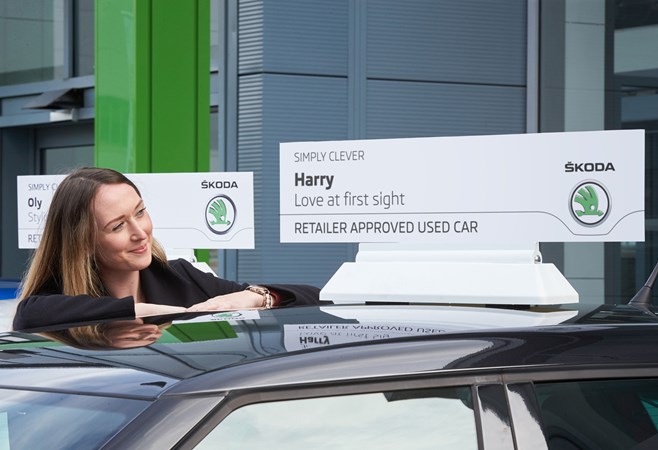
We found a couple of early 2020 cars for under £18,000 and slightly lower spec ones for under £16,500. However, given the info we showed in the ‘Cash Buy’ Option 1 [A new car for £18,636] – you should be able to drive a really hard bargain with most dealers.
As the Scala is fairly new [2019 onwards], the amount of good late cars should gradually increase going into 2021.
Search for your used Skoda Scala on Parkers here
| The Latest Data: Skoda Scala SE L 1.5TSI 150PS DGS stats – Updated 31/07/2020 |
|
| Current mileage | 4877 |
| Real-world average fuel economy | 51.67 mpg |
| Real-world miles-per-litre (combined overall) | 11.48 mpl |
| Official combined fuel economy (WLTP figures) | 42.2 – 48.8 mpg |
| Total fuel used cumulative | 483.10 litres |
| Total cost of fuel used | £633.53 |
| Parkers ‘MPP’ (Miles Per Pound) calculation | 7.1 – 8.1 |
| Car joined Parkers fleet | January 2020 |
Percy Lawman, Senior Product Content Manager – July 31st 2020



